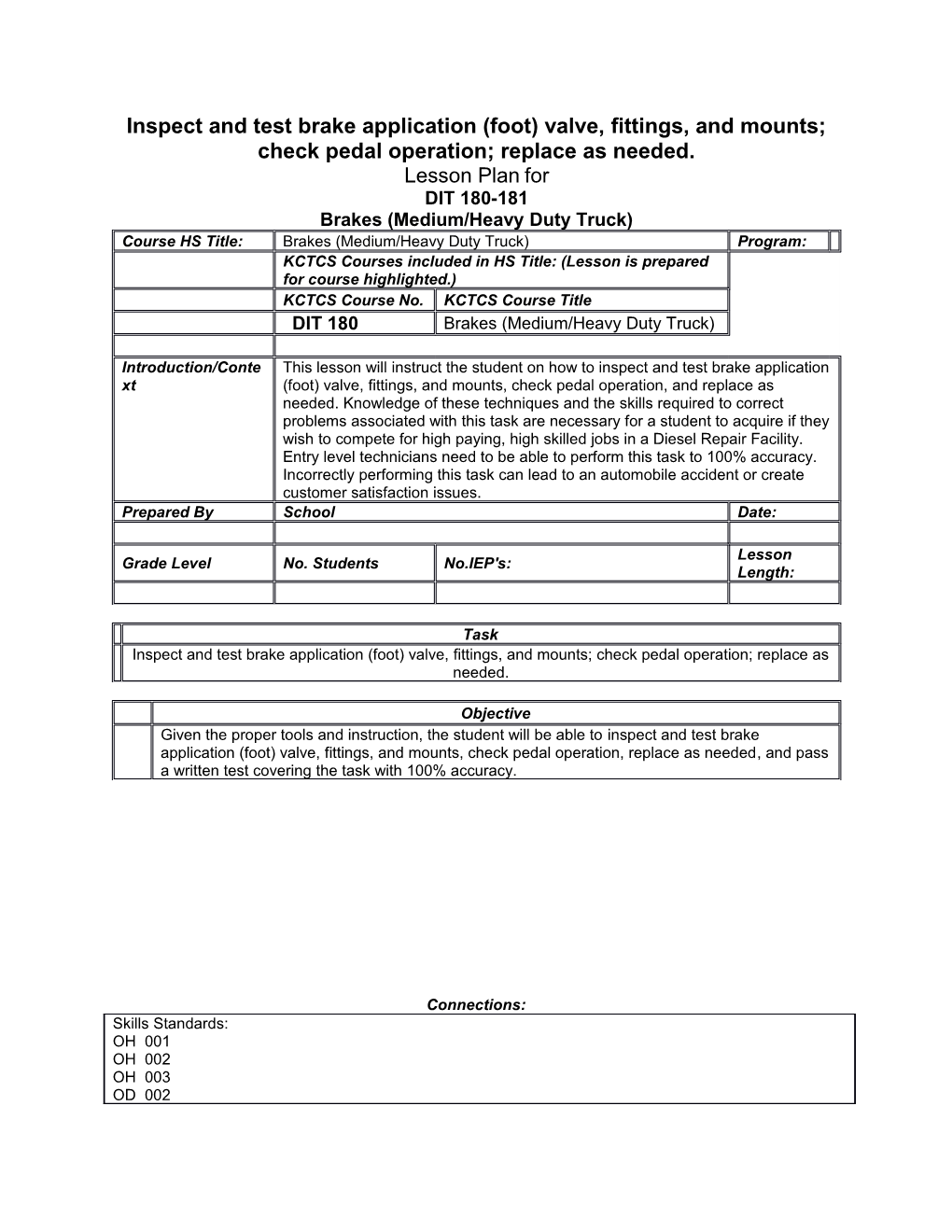Inspect and test brake application (foot) valve, fittings, and mounts; check pedal operation; replace as needed.
Lesson Plan for
DIT 180-181
Brakes (Medium/Heavy Duty Truck)
Course HS Title: / Brakes (Medium/Heavy Duty Truck) / Program:KCTCS Courses included in HS Title: (Lesson is prepared for course highlighted.)
KCTCS Course No. / KCTCS Course Title
DIT 180 / Brakes (Medium/Heavy Duty Truck)
Introduction/Context / This lesson will instruct the student on how to inspect and test brake application (foot) valve, fittings, and mounts, check pedal operation, and replace as needed. Knowledge of these techniques and the skills required to correct problems associated with this task are necessary for a student to acquire if they wish to compete for high paying, high skilled jobs in a Diesel Repair Facility. Entry level technicians need to be able to perform this task to 100% accuracy. Incorrectly performing this task can lead to an automobile accident or create customer satisfaction issues.
Prepared By / School / Date:
Grade Level / No. Students / No.IEP's: / Lesson Length:
Task
Inspect and test brake application (foot) valve, fittings, and mounts; check pedal operation; replace as needed.
Objective
Given the proper tools and instruction, the student will be able to inspect and test brake application (foot) valve, fittings, and mounts, check pedal operation, replace as needed, and pass a written test covering the task with 100% accuracy.
Connections:
Skills Standards:OH 001
OH 002
OH 003
OD 002
OD 003
OD 005
Common Core Technical Standards:
TD-OPS.2
TD-SYS.2
New Common Core State Standards:
RST 11-12 3
RST 11-12 2
INSTRUCTIONAL MATERIALS/TECHNOLOGY
Teacher Designed Materials and Other Handouts
Textbooks and Workbooks
Various / Brakes Medium/Heavy Truck ASE Test Prep T4 / Fifth / Delmar / 19
Equipment
Content/Presentation/Demonstration Outline
Tell students that the treadle valve is actuated mechanically, that is, by foot pressure from the driver. When the driver’s foot acts on the treadle valve, the primary piston is forced downward. This movement first closes the primary exhaust port and then modulates air proportional to piston travel to do the following:
1. Actuate whatever brakes are plumbed into the primary circuit. This is usually, but not always, the drive axles on a typical tandem drive tractor unit.
2. Actuate the relay or secondary piston, located below the primary section in a dual- circuit application valve.
3. Act against the mechanical pressure (foot pressure) to provide brake feel.
Inform them that the secondary or relay section of the dual-circuit application valve is actuated pneumatically by primary circuit air. Explain that this section operates similarly to a relay valve in that a signal pressure value (the air from the primary section) is used to displace a relay piston that then modulates secondary circuit air to whatever brakes/valves are located in the secondary circuit. Tell students that in a typical tractor air brake system, this would normally be the front axle brakes. Like a relay valve, secondary section is designed to modulate an air pressure value to the secondary circuit, identical to the signal pressure.
Instruct students that in an emergency application of the treadle valve, both the primary and secondary inlet valves are held open and full reservoir pressure is applied to each of the two circuits.
Tell students that in the event of a total primary circuit failure, no air is available to the primary section of the treadle valve. The dash low pressure warning alerts would trip, and when the treadle valve is depressed, foot pressure would drive the primary piston downward until it mechanically contacts the relay piston to actuate the secondary circuit.
In the event of a total secondary circuit failure, tell students that the primary section of the treadle valve would function normally. However, the dash low air pressure alert would trip and the vehicle would have to be brought to a halt using primary circuit source air only.
Explain that the valve can be tested for proper air delivery using pressure gauges plumbed to the supply and delivery ports. A leak at the exhaust port of the valve can indicate that the valve is faulty or that there is a leak somewhere else in the system and the air is back-feeding to the normally open exhaust port.
Tell students that the valve and fittings can be checked for air leaks using a soapy water solution. The pedal should return to the release position fully. A sticking pedal can allow a small amount of air pressure to remain in the brake chamber and result in dragging brakes.
Applications/Practice
Evaluation and feedback Prior to Testing or Lab Work
STUDENT ASSESSMENT:(Assess student progress with performance criteria.)
IMPACT--Reflection/Analysis of Teaching and Learning: (How did students’ progress in relation to the state objectives? Was the instruction successful? Analyze samples of student work particularly that which is unsatisfactory, for the purpose of planning further instruction.)
REFINEMENT--Lesson Extension and Follow-up: (To be filled in as the lesson is modified during initial planning and/or during the teaching learning process.)
